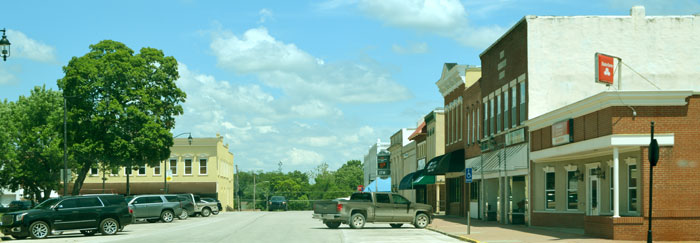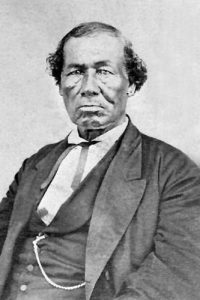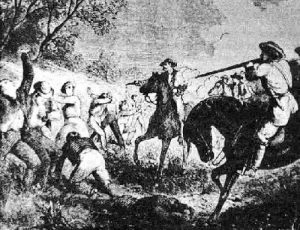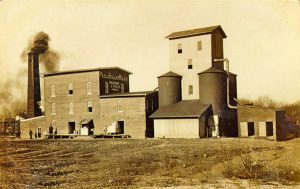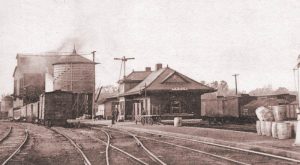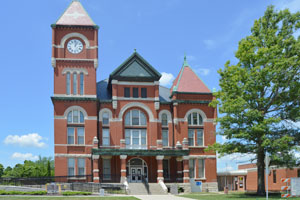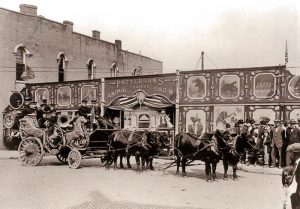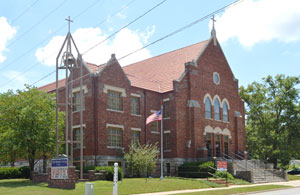Paola, Kansas, located in the center of Miami County, is the county seat and the largest city in the county.
At the start of the 19th century, the area was primarily controlled by the Osage Indians. However, more natives came when the Kaskaskia, Peoria, Wea, and Piankashaw tribes were forced to move to the region between 1827 and 1832. These tribes formed the Confederated Allied Tribe, led by Baptiste Peoria, who was of both French and Native American descent. They called their settlement Peoria Village.
By the 1840s, white settlers began to move to the area, and several missionaries lived in and near “Peoria Village.” In 1852, an Italian priest, Paul D. Ponziglione, arrived and renamed the village Paola after a small town on the coast of Calabria, Italy.
By 1854, many settlers had moved to the settlement, and a townsite was established by 1855. Indian leader Baptiste Peoria conveyed the land, now the town square, to the Paola Town Company as part of a peace treaty. The company also acquired title to about 400 acres of land.
The Paola Town Company later donated the square to the City of Paola, with the provision that no building be constructed on it, a provision that has been honored to this day. That year, the Paola Town Company was incorporated and became the county seat. S. P. Boone built the first house for Isaac Jacobs, a Mr. White the second, and Cyrus Shaw opened a store in December 1855 in a building erected by the town company. Later, the town company built a St. Charles Hotel on the site of their first building. At the end of the year, Paola had approximately 30 residents.
Paola gained a post office on February 13, 1856, and the first school was opened in the fall, with May Williams as the teacher.
In June 1857, Baptiste Peoria was elected president of the town company. Baptiste Peoria and his wife, Mary Ann Isaacs, are credited with being influential in the founding and development of the community through the mid-1860s.
The first school was started in 1857 by Mrs. Cyrus Shaw.
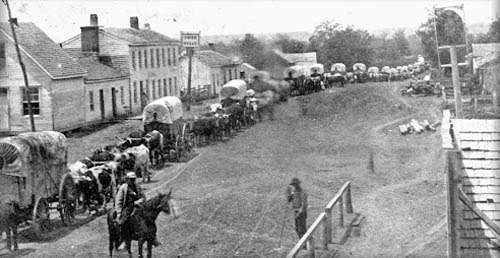
Early day, Paola, Kansas.
In 1858, the town of Osawatomie challenged Paola for the County Seat. However, when the vote was complete, it remained in Paola.
Religion was a significant aspect of the community, and the Methodist Episcopal Church was established on the Stanton circuit in 1858, where it remained until 1864, when a local church organization was formed. The Baptist church was established in 1860; the Catholic church may be regarded as the continuation of the Catholic mission established among the New York Indians in 1845, but no church was erected until 1860. Other denominations followed.
The border troubles stunted the town’s growth, but by 1859, peace was restored, and the prospects for Paola looked brighter. In 1860, Paola was incorporated. In the same year, Paola and the rest of the Kansas Territory experienced a drought, and the following year, the Civil War broke out, which brought activity to a standstill for four years. During this time, neither person nor property was considered safe in the border counties because of the threatened invasions of the Confederates and the raids of the bushwhackers from Missouri.
During the Civil War, a military post was established on the west side of Bull Creek, just west of Paola. The new town was barely spared an attack by Confederate guerrilla William Quantrill on August 21, 1863, as he retreated after the Lawrence, Kansas Massacre. Paola was also just 10 miles west of the retreat of Confederate Major General Sterling Price’s force on October 24, 1864. The nearby military post was deactivated in August or September 1865.
Few people were added to the population, and it was not until the close of hostilities and the prospect of a railroad that the town began to improve.
During the war, pressure to move the Native American tribes increased, and they were moved to Oklahoma by 1868. Some individuals stayed and became citizens of the United States; however, their leader, Baptiste Peoria, left with the tribe for Paola. From the late 1860s through the 1870s, Paola grew and developed, establishing its first school, jail, and bank.

Vintage Paola, Kansas.
The first newspaper in Paola was the Miami Republican, which first appeared on August 18, 1866.
In 1867, the original gazebo and a bandstand were put on the square. At that time, the square served as a horse racetrack and a central gathering point for parades, celebrations, and other community events.
The Kansas City, Fort Scott, and Gulf Railroad arrived in Paola in 1870, which significantly contributed to its growth and development. The line ran north-south, connecting Hillsdale, Paola, and Fontana with Kansas City, Fort Scott, and points beyond.
The Western Spirit newspaper appeared on June 8, 1871, and was the leading paper of the town and county for more than 100 years. It was discontinued on June 7, 1978.
In 1872, a fine school building was erected for $65,000. The Kansas Normal School and Business Institute was located in a three-story brick building.
In August 1874, the hotel was destroyed by fire.
On January 1, 1876, the first bank opened. The Miami County Bank opened in a small frame building on the north side of Peoria Street with a capital of $50,000. The following year, the company erected a two-story brick building on the southeast corner of Peoria and Pearl Streets for $6,400.
In the early 1880s, Paola boasted four dry goods stores, five drugstores, two hardware stores, three agricultural implement dealers, two grain dealers, three hotels, five blacksmith shops, three wagon manufacturers, two carriage manufacturers, two flouring mills, three harness shops, three furniture stores, three lumber yards, a flour, and grain store, four carpenter shops, eight physicians, 15 lawyers, two jewelry stores, four saloons, and other various business.
Following the discovery of natural gas in 1882, Paola became the first town west of the Mississippi River to use it commercially and to be illuminated with natural gas lanterns. The same year, the Paola Iron Works was established in June by Joseph, A.J., J.I. Clandon, and J.W. Vilke. The works comprised an iron foundry and a machine shop.
The first oil well west of the Mississippi River was discovered north of the Lykins Mission site in 1888. A small refinery was constructed in the early 1890s to process the oil.
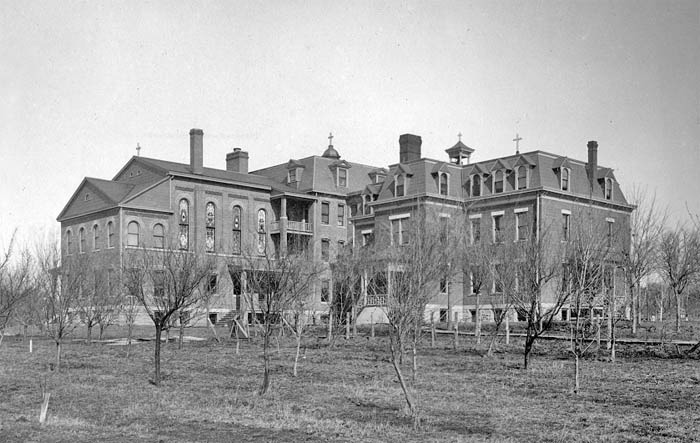
Ursuline Academy, Paola, Kansas.
In 1894, two Catholic Ursuline Sisters from Louisville, Kentucky, visited Paola to explore the possibility of establishing an Academy and Convent. Their original intent was to educate the Indians of Eastern Kansas. However, by that time, most of the area’s Indigenous peoples had already relocated to a reservation in Miami, Oklahoma.
Several towns offered the Sisters sites for the school, but Paola businessmen offered the Sisters five acres on East Wea Street. St. Angela’s Hall was completed in March 1896 at a cost of $14,000, and the school opened in September with four boarders and 40 day students.
In 1898, the Miami County Courthouse was built and designed by architect George Washburn. Several other buildings were also designed by Washburn, including the Paola Park Square gazebo, the Paola Library, and several homes.
By 1904, St. Angela’s Hall was becoming too small to accommodate the increasing enrollment. An additional 3.5 acres were purchased, and construction of a second building began that summer. Brescia Hall was built next to and connected to the original building. It was built for $22,000 and housed a chapel, dormitories, a dining hall, and a recreation area. Over the next few years, the school’s grounds expanded to 30 acres, and additional buildings were constructed.
By 1910, the St. Louis and San Francisco, Missouri, Kansas & Texas, and Missouri Pacific railway systems had lines radiating in six directions from Paola. As such, the town was an important shipping center for the affluent agricultural district that surrounded it. At that time, the town had a population of 3,207.
In 1912, James Patterson relocated to Paola to establish his winter quarters for the Patterson Circus, a traveling circus. The circus continued until 1927. A mural based on a 1924 circus pamphlet is at 106 W. Peoria. The Pattersons’ home still stands in Paola in the 600 block of North Mulberry, as the only remaining structure from the circus winter headquarters.
The Ursuline Sisters operated the Academy as a grade and high school until 1924, when the grade school was closed and a junior college curriculum was added. The Ursuline College of Paola was closed in 1957, and the high school was discontinued in 1971.
Today, Paola Park Square is still revered as the heart of the downtown area and remains a central meeting and gathering place. Annually, Paola hosts the Miami County Fair in July, the Roots Festival in August, and the Harvest Festival in October.
Paola has a population of approximately 5,700 people today.
©Kathy Alexander/Legends of Kansas, updated December 2025.
Also See:
Sources:
Blackmar, Frank W.; Kansas: A Cyclopedia of State History, Vol I; Standard Publishing Company, Chicago, IL 1912.
City of Paola, Kansas
Cutler, William G.; History of Kansas; A. T. Andreas, Chicago, IL, 1883.
Ursuline Sisters
Wikipedia

